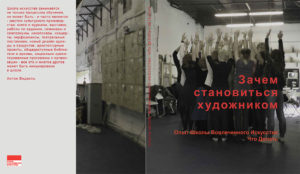realized for the exhibition “Educational Web” at Kunstverein in Hamburg (April – August 2023)
This exhibition project has a long history, beginning during the Covid epidemic, it was postponed several times and changed several places of realization. Now it has materialized in a completely new reality shaped by war, the flight of graduates and teachers from Russia and Ukraine, and a situation where the meanings of things has seemingly collapsed.
In 2022, our project The School of Engaged Art in St. Petersburg ceased to exist. This was also marked by our exodus from our city, along with most of the community of critically minded artists, researchers, and activists that called St. Petersburg home. This is not to say that we were not prepared for this situation. During the first enrolment of the school in 2013, we experienced shock when the outbreak of war and the annexation of Crimea occurred. Our school always had many participants from Ukraine. Tragically, we experienced the breakup of our shared post-Soviet space. This year will be the school’s tenth anniversary, and looking back, we have been operating and learning in a state of emergency this whole time, but even in this generally hostile situation, we have managed to find ways to talk, create new works, and exercise our autonomy. But the escalation of a full-scale war and the rise of fascist tendencies in Russia have left us no chance of surviving even in the dissident model of confidential counter-public space. Now we are forced to change our work completely, following the flows of migration of our alumni and faculty who have found themselves in the most unexpected places.
Our school has lost its home, the place where it was rooted, and has become a wandering structure of the School of Emergencies, open to different contexts and a new assembly of confused bodies and thoughts. We have become homeless. More precisely, we begin to build our home from where we are now, from where our beds stand. From a place where we can stop along the way and begin to think about what the future holds for us and how we can care about a common future. But our beds don’t give us rest—they are like boats in a stormy sea, on the waves of which we are tossed with the rest of the other migrants. We are looking for a way to navigate, and here we are helped by memories of our Comrade-Blanket. This is an object that our school’s participants made back in 2016, and since then, it has served to shelter many sleeping bodies, tired from discussion or dance—it doesn’t matter. It’s a powerful tool for producing shared dreams and solidarity.
Changing from year to year, now with portraits of our (un)queer-(un)dead-teachers, it covers our restless beds, again uniting us and sustaining us. Flashback-fragments of video works carried out by participants in the school throughout its activity take us back in time, and we see some documentation of the school activities – like publications, quotes, photos at our archival documentation scrolls. This textile are coming together on the podiums with our maquettes of our educational process and former Rosa House of Culture also look to our lost past while proposing a possible future.
One model shows the Rosa House with Haim Sokol’s last exhibition on the walls. Everything is the same, but flooded by the waves of that same raging sea where our beds still float. The class of Political Magic, the class of Celestial Hardwood study, the class of External Environment study—these models are now populated by non-human beings, new students whose bodies have been transformed to survive in our perhaps already post-apocalyptic reality.












